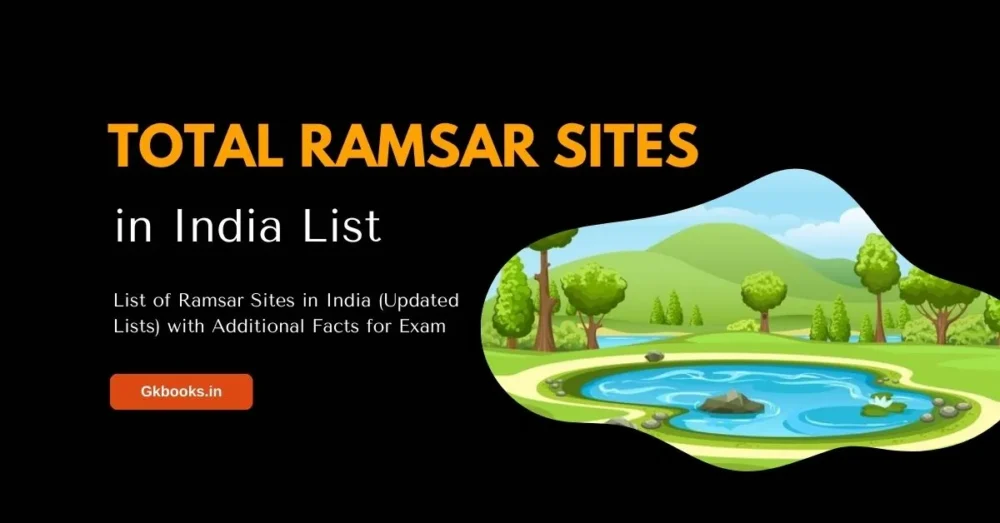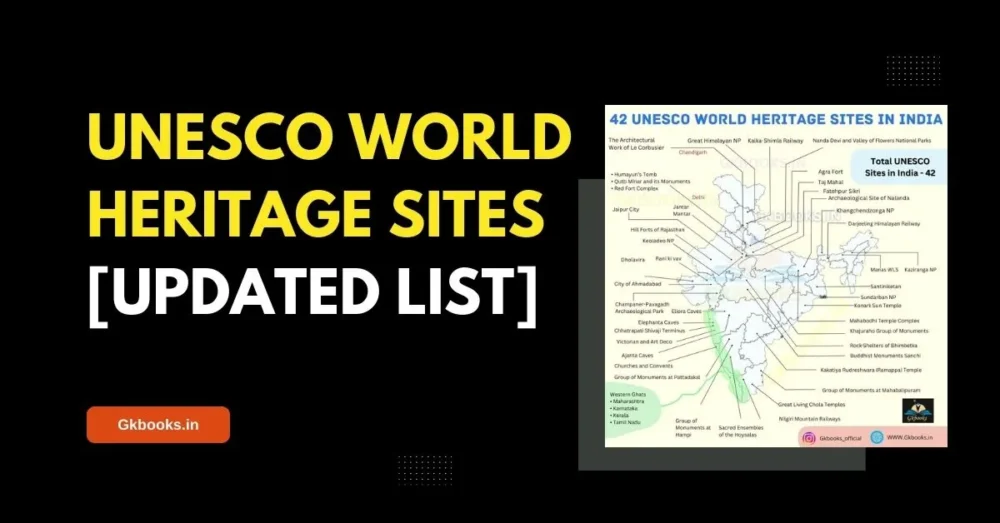Harike Wetland, also known as Hari-ke-Pattan, is one of the most prominent Protected Areas of India and has been designated as a Ramsar Site due to its ecological importance. Situated at the confluence of the Beas and Sutlej rivers, this wetland is not only a critical habitat for diverse wildlife but also a key topic in various competitive exams like SSC, WBCS, UPSC, RRB NTPC, and other state-level exams.
Questions related to Harike Wetland often appear in exams, particularly in sections focused on environmental conservation and protected areas. Understanding the significance of this wetland is essential for exam preparation, as it highlights India’s commitment to preserving biodiversity and maintaining ecological balance.
Formation and Significance
- The formation of this remarkable wetland and lake dates back to 1953 when headworks were built across the Sutlej River.
- This infrastructure is situated downstream from where the Beas and Sutlej rivers meet, just south of Harike village.
- The wetland features a rich diversity of species, playing an essential role in sustaining the vital hydrological balance within the region.
- It is home to a vast number of migratory waterfowl, including several globally threatened species.
- It ranks just behind the Keoladeo National Park near Bharatpur for its significance in avian diversity.
- The Ramsar Convention designated Harike Wetland a Ramsar site in 1990, recognizing its ecological importance and aiming to support the conservation, development, and preservation of its unique ecosystem.
- This area stands as the largest wetland in northern India, straddling the borders of Tarn Taran Sahib and Ferozepur districts in the state of Punjab.

A Man-Made Marvel
- Harike Wetland covers an area of 4100 hectares.
- It is a man-made wetland that includes parts of the Tarn Taran Sahib, Ferozepur, and Kapurthala districts in Punjab.Since 1987-88.
The conservation of Harike Wetland has been prioritized by:
- The Ministry of Environment and Forests of the Government of India.
- The Punjab State Government.
- Numerous studies and management programs have been executed over the years to Enhance this vital ecological asset and Protect the wetland.
Harike’s Location and Connectivity
- Harike, also known as Hari-ke-Pattan, is the closest town to the Harike Wetland.
- The nearest Makhu Railway Station and Bus Stand are located about 10 kilometers south of Harike.
- This town is well-connected by the National Highway, facilitating travel to Ferozepur, Faridkot, and Bhatinda.
Hydrology and engineering aspects
- The monsoon climate predominantly influences the area that drains into the Harike Wetland.
- Constructed on the Sutlej River, just downstream from its meeting point with the Beas River, the headworks serve as an essential project.
- This initiative has created Harike Lake and expanded the wetland, acting as a key source for irrigation and drinking water supplies.
- Water is channeled through the Ferozepur, Rajasthan, and Makhu feeder canals, which can carry up to 29,000 cubic feet per second (or 820 m³/s). This infrastructure supports command areas in the states of Punjab and Rajasthan.
- The impressive Indira Gandhi Canal in Rajasthan receives its water from this system.
- The lake itself is triangular in shape, with its tip pointing west.
- It is bordered by the Dhussi Bund on one side, a canal on another, and a major road on the third side.
- Surrounding the lake are vast agricultural lands, and the wetland is known to possess abundant groundwater resources.
Water quality
- According to the Punjab State Council for Science & Technology, the water quality of Harike Lake is primarily classified as ‘A’ Class, meeting the standards for its best use.This is impressive, especially
- considering that substantial amounts of polluted water are released into the wetland from nearby industries and urban centers.
Biodiversity
- This diverse array of wildlife is said to be quite distinctive.
- The wetland boasts a rich biodiversity, home to a variety of species, including birds, turtles, snakes, amphibians, fish, and invertebrates.
Bird Sanctuary
- The wetland was designated as a bird sanctuary in 1982, officially named the Harike Pattan Bird Sanctuary, covering an extensive area of 8,600 hectares.
- Between 1980 and 1985, the Bombay Natural History Society (BNHS) conducted research and implemented a bird-ringing program in the area.
- BNHS also proposed the establishment of an ornithological field laboratory to further study the diverse avian life.
- During the winter season, approximately 200 bird species visit the wetland.
Some notable species include:
- Cotton pygmy goose (Nettapus coromandelianus)
- Tufted duck (Aythya fuligula)
- Yellow-crowned woodpecker (Dendrocopos mahrattensis)
- Yellow-eyed pigeon (Columba eversmanni)
- Water cock (Gallicrex cinerea)
- Pallas’s gull (Ichthyaetus ichthyaetus)
- Brown-headed gull (Chroicocephalus brunnicephalus)
- Black-headed gull (Chroicocephalus ridibundus)
- Yellow-footed gull (Larus michahellis)
- Indian skimmer (Rynchops albicollis)
- White-winged tern (Chlidonias leucopterus)
- White-rumped vulture (Gyps bengalensis)
- Hen harrier (Circus cyaneus)
- Eurasian tree sparrow (Passer montanus)
- Hawk (subfamily Accipitrinae)
- Eurasian hobby (Falco subbuteo)
- Horned grebe (Podiceps auritus)
- Black-necked grebe (Podiceps nigricollis)
- Great crested grebe (Podiceps cristatus)
- White-browed fantail (Rhipidura aureola)
- Brown shrike (Lanius cristatus)
- Common woodshrike (Tephrodornis pondicerianus)
- White-tailed stonechat (Saxicola leucurus)
- White-crowned penduline tit (Remiz coronatus)
- Rufous-vented grass babbler (Laticilla burnesii)
- Striated grassbird (Megalurus palustris)
- Cetti’s warbler (Cettia cetti)
- Sulphur-bellied warbler (Phylloscopus griseolus)
Vegetation
- The State Wildlife Department has created earthen mounds in the marsh area, planting trees on them to enhance nesting sites for birds.
- The wetland features a rich variety of floating vegetation, which includes:
- Eichhornia crassipes, which covers 50% of the area.
- Azolla sp., found sparsely in open water regions.
- Nelumbo nucifera, commonly known as lotus, is the main rooted floating plant.
- Ipomoea aquatica is located along the lake’s edges in shallower waters.
- Submerged vegetation includes species like Najas, Hydrilla, Ceratophyllum, Potamogeton, Vallisneria (eelgrass or tape grass), and Charales.
- Typha sp. is the most prevalent emergent marsh plant.
- Small floating islands form from Eichhornia crassipes and other grasses in the mud and root zones throughout the wetland.
- Along the embankment, trees such as Dalbergia sissoo, Acacia nilotica, Zizyphus sp., Ficus sp., and the alien species Prosopis juliflora grow in dense clusters.
Aqua fauna
- The wetland is home to endangered turtles and smooth-coated otters, both of which are listed in the IUCN Red List of threatened species.
A total of 26 fish species have been recorded, including:
- Rohu
- Catla
- Puntius
- Cirrhina
- Channa
- Mystus
- Chitala chitala
- Cyprinus
- Ambassis ranga
Various invertebrates have also been documented, including:
- Protozoans (5 & 21 taxa)
- Molluscs (39 & 4 taxa)
- Insects (6 & 32 taxa)
- Crustaceans (27 taxa)
- Annelids (7 taxa)
- Nematodes (7 & 4 taxa)
- Rotifers (59 & 13 taxa)
Rediscovery of the Indus Dolphin in India
- The Indus dolphin (Platanista gangetica minor), once thought to be extinct in India since 1930, has made a surprising return!
- These fascinating aquatic mammals, primarily found in the Indus River system of Pakistan, were recently spotted in the Beas River near the Harike wetland area.
- This sighting is significant, especially since the species is listed as endangered in the Red Data Book of the International Union for the Conservation of Nature (IUCN).
A Remarkable Discovery
- On the morning of December 14, 2007, Basanta Rajkumar, an Indian Forest Service officer responsible for the area, spotted these dolphins while touring the region in a motorboat.
- Following this exciting discovery, a team of freshwater dolphin conservationists from the World Wildlife Fund (WWF) India was called in to conduct a survey.
- They observed a family of about six dolphins at two different locations along a 25-km stretch of the Beas River, confirming the claims made by state forest officials.
Confirmation from Experts
- The find has been validated by an authority on freshwater dolphins from the Wildlife Institute of India in Dehradun, which specializes in managing endangered species.
- This remarkable discovery in 2007, a year designated by the United Nations as Dolphin Year, was celebrated as a notable event.
- Interestingly, about 140 km downstream from the Harike Barrage, in Pakistan, Indus dolphins are frequently observed, highlighting the unique habitat of this endangered species.
Conservation Efforts for the Gharial
- The gharial (Gavialis gangeticus), a unique species of crocodile, was once abundant in the Indus River system.
- However, due to significant declines in its population, it is now classified as critically endangered on the International Union for Conservation of Nature’s (IUCN) Red List of Endangered Species.
A New Initiative in Punjab
- In a bid to revive this remarkable species, the Punjab Government is taking proactive measures. They plan to release 10 gharials into the Harike Wetlands.
- This initiative aims not only to bolster the gharial population but also to attract more tourists to the region.
Challenges Facing the Harike Wetlands
- The Harike Wetlands, in existence since 1953, have experienced significant transformations over the years due to various factors. Here are some of the key issues impacting this vital ecosystem:
1. Encroachments and Agricultural Practices
- Encroachments on the wetland habitat for intensive agriculture have led to the influx of agricultural chemicals into the area. This practice, alongside controversial land use, has severely affected the wetland’s health.
2. Water Utilization
- The excessive use of surface and groundwater for irrigation has put immense pressure on the wetland, altering its natural flow patterns.
3. Pollution from Waste Discharge
- Untreated waste from towns, villages, and industrial activities is routinely discharged into the rivers that feed the wetland.
- This has resulted in significant pollution, with estimates indicating that about 700 million liters per day of polluted water is released.
- Consequently, there has been extensive growth of water hyacinth, a problematic invasive species, covering approximately 80% of the open water surface and enclosing 33 islands within the wetland.
4. Soil Erosion and Siltation
- Deforestation in the lower Shivalik hills, which form the wetland’s catchment area, has led to soil erosion and siltation, further impacting the ecosystem’s stability.
5. Illegal Activities
- Despite the protections provided under the Wildlife (Protection) Act, illegal fishing and poaching continue to threaten the area’s biodiversity.
6. Grazing Pressure
- Indiscriminate grazing in the catchment areas has caused further damage to the delicate wetland ecology.
Remote Sensing Findings
- A remote sensing study, combined with analyses of rainfall, water discharge, and groundwater levels, revealed that the flow patterns in the wetland have diminished.
- Over a 13-year study period, the size of the wetland area has decreased by approximately 30%.
Restoration Efforts
- The Harike Wetlands have faced significant degradation, prompting a variety of restoration measures initiated by numerous organizations, including central and state government agencies and local Indian Army Units. These collaborative efforts aim to rehabilitate this vital ecosystem through several key actions.
Harike Wetland Conservation Mission
- In 1998, the Chief Minister of Punjab established the Harike Wetland Conservation Mission with the following objectives:
- a) Master Plan Development: To create a comprehensive master plan for the integrated conservation and development of the Harike Wetland.
- b) Project Implementation: To carry out specific projects and programs focused on conserving the ecosystem of the Harike region.
- c) Regulation and Monitoring: To oversee and assess all development activities affecting the Harike Wetland ecosystem.
- d) Evaluation of Government Proposals: To review and evaluate all plans and proposals from government departments that impact the future of Harike.
Combatting Water Hyacinth
- The issue of water hyacinth, an invasive plant species choking the wetland, was addressed in 2000 through a collaborative initiative between the Indian Army (Western Command, Vajra Corps) and the Chief Minister.
- Under the pilot project named “Sahyog,” the Army implemented innovative mechanical systems for weed removal.
An Army General reported on their progress, stating:
“Through various innovative methods, we created dynamic booms and winches. After the operation, we strategically placed static and dynamic booms in Harike Lake to prevent the further spread of water hyacinth. After six months of dedicated work by our team, we successfully opened four channels that had been choked with silt over the years. Additionally, we planted 750 saplings of two-year-old plants on the islands for birds to nest and roost in the future.”
Management Plan by Punjab State Council for Science and Technology
The Punjab State Council for Science and Technology developed a management plan that includes the following actions:
- Opening sluice gates during monsoon seasons to regulate water flow.
- Monitoring water quality during migration periods to ensure a healthy ecosystem.
- Fencing selected areas to protect them from encroachment.
- Afforestation of the catchment area to enhance biodiversity.
- Surveying, mapping, and notification of wetland boundaries and resources.
- Soil conservation initiatives to prevent erosion and degradation.
- Education and public awareness campaigns to engage the community in conservation efforts.
Celebration of World Wetlands Day at Harike
- On February 2, 2003, World Wetlands Day was celebrated at Harike, emphasizing the crucial message: “No Wetlands, No Water.”
- This event not only highlighted the importance of wetlands but also coincided with the International Year of Freshwater.
Significance of the Celebration
- The day served as a reminder of the vital role wetlands play in maintaining healthy ecosystems and providing essential resources such as clean water.
- Celebrating this occasion at Harike helped raise awareness among local communities and stakeholders about the significance of wetland conservation and sustainable water management.
Explore More Protected Areas of India:
Mastering 93 Ramsar Sites in India UPSC Notes [2025]: Updated List
Complete List of Tiger Reserves in India [2025] with MAP and Key Facts
Madhav National Park: India’s 58th Tiger Reserve and Its Conservation Significance
43 UNESCO World Heritage Sites in India 2025 with Maps and Key Facts
Project Tiger Facts | History, Year, Objectives, Challenges, & More




